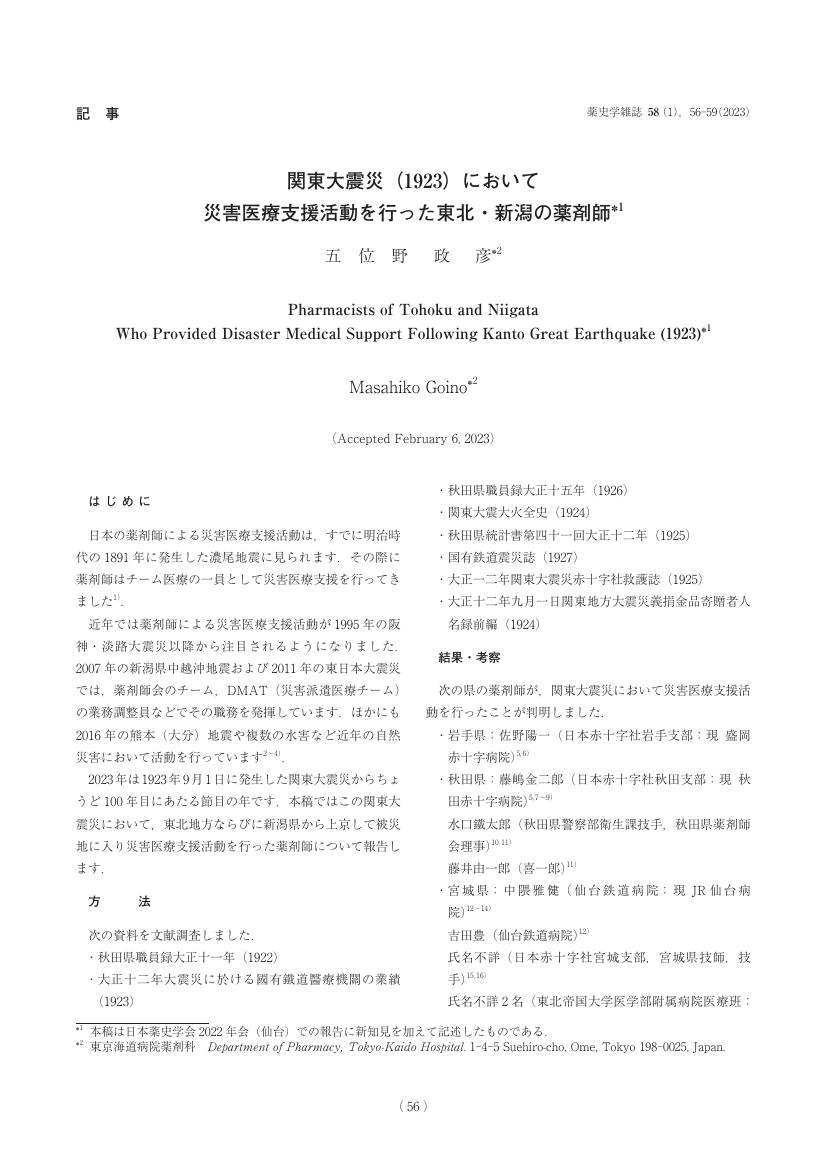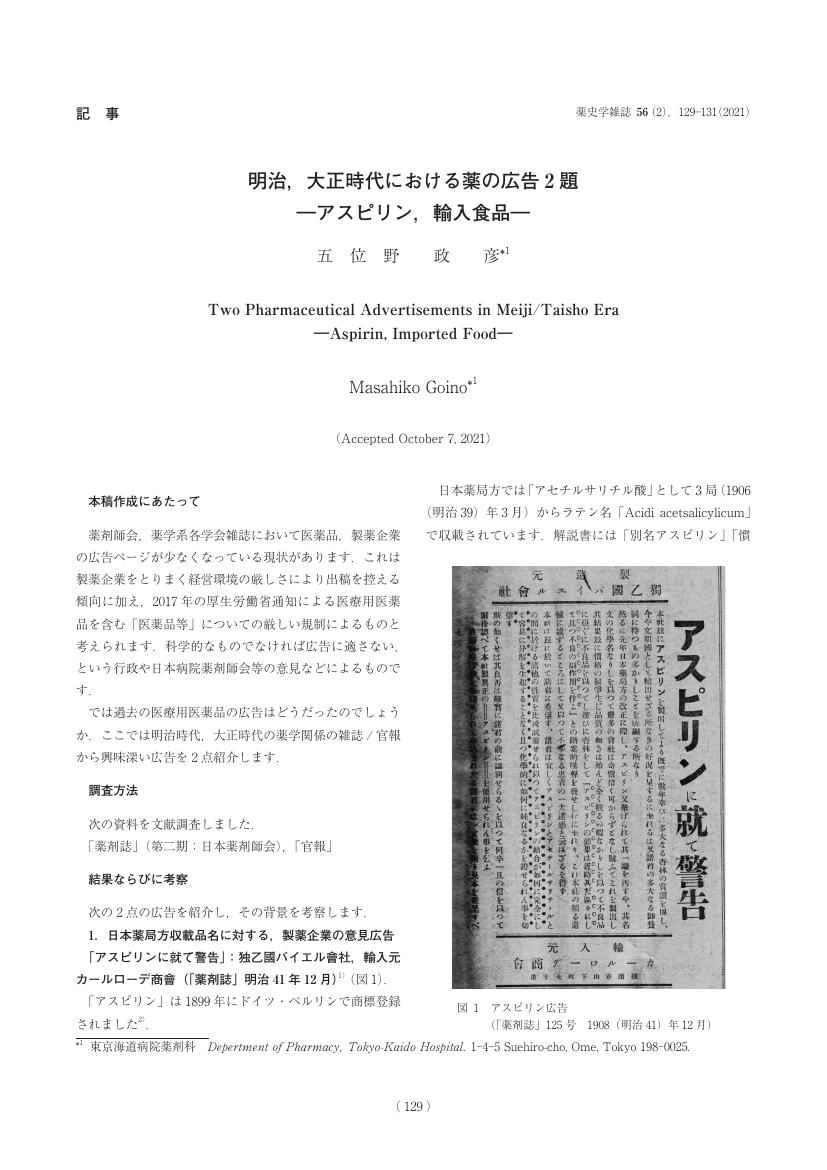39 0 0 0 OA 薬剤師,薬学の登場するマンガ,コミックの歴史
- 著者
- 五位野 政彦
- 出版者
- 日本薬史学会
- 雑誌
- 薬史学雑誌 (ISSN:02852314)
- 巻号頁・発行日
- vol.55, no.2, pp.241-244, 2020 (Released:2021-01-28)
25 0 0 0 昭和時代の日本漫画「サザエさん」に登場する医薬品と薬学関連事項
- 著者
- 五位野 政彦
- 出版者
- 日本薬史学会
- 雑誌
- 薬史学雑誌 (ISSN:02852314)
- 巻号頁・発行日
- vol.44, no.1, pp.38-43, 2009
10 0 0 0 OA 関東大震災(1923)において災害医療支援活動を行った東北・新潟の薬剤師
- 著者
- 五位野 政彦
- 出版者
- 日本薬史学会
- 雑誌
- 薬史学雑誌 (ISSN:02852314)
- 巻号頁・発行日
- vol.58, no.1, pp.56-59, 2023 (Released:2023-08-10)
10 0 0 0 OA 「坐薬」:言葉の由来とその日本における受容過程
- 著者
- 五位野 政彦
- 出版者
- 日本薬史学会
- 雑誌
- 薬史学雑誌 (ISSN:02852314)
- 巻号頁・発行日
- vol.58, no.1, pp.18-25, 2023 (Released:2023-08-10)
序論:本稿では日本語の「坐薬」の語源,ならびに日本の近代医療でこの剤形が受容されてきた過程を調査した. 方法:次の資料を調査した.国立国会図書館デジタルコレクション収蔵史料,京都大学図書館収蔵史料,早稲田大学図書館収蔵史料,Google Books 検索結果,個人収蔵史料 結果・考察:江戸ハルマ(波留麻和解)にはオランダ語の「zetpil」の訳語として「?薬」の語があてられている.これは『金匱要略』に見られる用語であるとともに,zet:座る,pil:薬をそのまま意訳したものである.また冒頭の「ゼ」を「?」とすることで音訳も兼ねていた.しかし蘭方では坐剤は用いられなかった.明治時代の日本の近代医療導入過程において,英国医学を導入した時期に坐剤の具体的な情報がもたらされた.しかしその後のドイツ医学導入により,初版,改正日本薬局方では坐剤は収載されなかった.日本人により編纂され,医療の現場で使用されている医薬品の規定を目的とした第三改正日本薬局方に坐剤が収載された.
5 0 0 0 OA 明治時代の精神科医療における医薬品―医学資料からの調査―
- 著者
- 五位野 政彦
- 出版者
- 日本薬史学会
- 雑誌
- 薬史学雑誌 (ISSN:02852314)
- 巻号頁・発行日
- vol.56, no.1, pp.25-38, 2021 (Released:2021-08-07)
序論:明治時代には,ドパミン,モノアミンに基づく精神疾患用医薬品は存在していなかった.本研究では,明治時代の日本におけるに精神科医療においてどのような医薬品をどのような患者に使用していたかを調査した. 方法:次の資料を文献調査した.国立国会図書館デジタルライブラリー収蔵資料ならびにグーグルスカラー検索結果によるドイツ薬局方.これらは医学資料のみであり,薬局方を除いて薬学資料はない. 結果・考察:明治時代を通じて,日本の精神科医は日本の伝統的医薬品でなく欧州由来の医薬品を使用していた.これらの医薬品はドパミンやモノアミンに対する作用はなかった.しかしこれら医薬品は患者の休息や精神症状の遅延をもたらした.当時,精神科医が使用した医薬品の多くは麻酔薬ないし睡眠薬であった.とくに処方されたのはオピオイド(阿片,モルヒネ等),ベラドンナアルカロイド(スコポラミン等)あるいはハロゲン化合物であった.20 世紀初頭にバルビツレートならびに他睡眠薬が欧州の複数の製薬会社により開発された.これらにより精神科医は患者の治療を行うことが可能になった.精神科では脳内の血流が精神疾患を発症させると考えられていたため,ジギタリスのような強心薬を用いて血液循環の改善をはかった.日本の近代精神医学の父である呉秀三は,患者の人権保護を考慮し,治療方法の改革を行った.これら医薬品は呉の活動をサポートした.
2 0 0 0 OA 明治時代の局方における「錠剤」ラテン名の変遷および「錠」の語源についての一考察
- 著者
- 五位野 政彦
- 出版者
- 日本薬史学会
- 雑誌
- 薬史学雑誌 (ISSN:02852314)
- 巻号頁・発行日
- vol.48, no.2, pp.169-174, 2013 (Released:2020-12-30)
Jo-zai or tablet is a most popular form of pharmaceutical dosage in modern Japan. The term jo-zai first appears in the Japanese Navy Pharmacopoeia, First Edition (1872). Its Latin name was translated as torikisuki and was written in Japanese katakana characters. Jo-zai translated as trochischi can also be found in the Japanese Pharmacopoeia, First Edition (JP1) (1897). Its Latin name and definition have changed several times : trochisichi ; pastilli, JP3 (1906) ; tablettae, JP5 (1932) ; tabellae : JP6 (1951), etc. The etymon of the word jo-zai is based on the English word, lozenge. Its square-shaped form is similar to old Japanese silver coins. During Japan's Edo era (1603-1868) and in ancient China, silver coins were called jo. Therefore the word lozenge was translated into Japanese as jo-zai,combining the character for coin with the one for drug, zai.
2 0 0 0 明治,大正時代における薬の広告 2 題―アスピリン,輸入食品―
- 著者
- 五位野 政彦
- 出版者
- 日本薬史学会
- 雑誌
- 薬史学雑誌 (ISSN:02852314)
- 巻号頁・発行日
- vol.56, no.2, pp.129-131, 2021
1 0 0 0 OA 『小學化學書』(明治7年)に見られる「乳鉢」の語とその背景
- 著者
- 五位野 政彦
- 出版者
- 日本薬史学会
- 雑誌
- 薬史学雑誌 (ISSN:02852314)
- 巻号頁・発行日
- vol.47, no.1, pp.90-93, 2012 (Released:2021-07-02)
The etymon of the Japanese word nyu-bachi (mortar) is unknown. The first step in the research process is to consult books on chemistry and pharmacy published in the 1870s, the first decade of the Meiji era when Japan began to modernize. The word nyu-bachi can be found in the Shogaku-Kagaku-Sho, published in 1874. Before 1873, the word usu (mil) is used in place of hachi or bachi, which also mean mortar. Before 1873, mills / mortars were used for crushing and grincling. In books published after 1873, one can find references in several books on chemistry and pharmacy to their use in mixing and dispensing. More in-depth research in the areas of pharmacy and Western-style cooking is necessary to determine the etymon.
1 0 0 0 OA 関東大水害(明治 43 年)における薬剤師の活動--医薬分業,飲用水検査--
- 著者
- 五位野 政彦
- 出版者
- 日本薬史学会
- 雑誌
- 薬史学雑誌 (ISSN:02852314)
- 巻号頁・発行日
- vol.55, no.2, pp.218-226, 2020 (Released:2021-01-28)
序論:薬剤師による最初の救助活動は明治 24 年の濃尾震災でみられた.本稿では明治 43 年の関東大水害において薬剤師がどのような災害救助活動を行ったかを調査した. 方法:次の施設に収蔵されている資料ならびに著者蔵の資料を調査した.東京都公文書館,東京薬科大学図書館,国立国会図書館デジタルコレクション 結果・考察:薬剤師が行った活動は 2 つに分類される.1. 医薬品供給 : 府立の治療所からは被災者向けに処方箋が発行され,日本薬剤師会東京支部会員薬局での無料調剤が実施された.2. 飲料水の検査,消毒薬の配布等の衛生薬学活動:飲料水の検査は府の検査員と薬剤師が共同で行った.これらの薬剤師の活動に対して,後日褒賞が行われた.特に神奈川県薬剤師会は,内務大臣からの表彰対象になった.
1 0 0 0 OA 明治,大正時代における薬の広告 2 題―アスピリン,輸入食品―
- 著者
- 五位野 政彦
- 出版者
- 日本薬史学会
- 雑誌
- 薬史学雑誌 (ISSN:02852314)
- 巻号頁・発行日
- vol.56, no.2, pp.129-131, 2021 (Released:2022-02-24)
1 0 0 0 OA 「乳鉢」の語が見られる中国古典籍とその語の語源に関する一仮説
- 著者
- 五位野 政彦
- 出版者
- 日本薬史学会
- 雑誌
- 薬史学雑誌 (ISSN:02852314)
- 巻号頁・発行日
- vol.48, no.2, pp.166-168, 2013 (Released:2020-12-30)
The word nyu-bachi (mortar) is seen in Shogaku-Kagaku-sho, a book of chemistry in 1874 but its etymon is unknown. The word ru-bo (nyu-bachi in Japanese) is seen in several ancient books in medicine, art and literature, from the 5th to 18th century. In these books, the usage of ru-bo is written as crush the solids. In 1874, the translator Tosen Hoda did not make a new Japanese word for mortar but used the ancient Chinese word ru-bo (nyu-bachi). This was because he found that the usage of European mortar is the same as that of the ancient Chinese ru-bo. The word nyu has several meanings. The etymon of the word nyu-bachi comes from the female breast nyu, not liquid nyu. The reasons are as follows : 1) the usage of ru-bo (nyu-bachi) is for solids, not liquids, and 2) the word bo (bachi) means hemisphere bowl. It may stand for a kind of humor in ancient Chinese male society.


